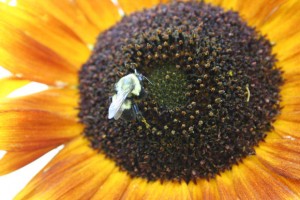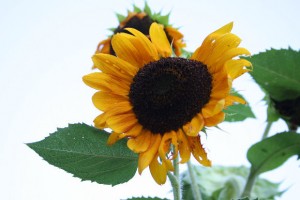 |
| Sunflower and bee |
The sunflowers in the garden have been blooming for quite some time now, and we should continue to enjoy their lovely presence for many weeks to come. During the spring, we noticed volunteers sprouting up along the southern side of the house where last year’s sunflowers contributed many seeds, thanks to the goldfinches that frequented the sunflower patch. The cats loved to sit in the windowsills and watch the birds – they were only inches away, just a pane of glass separating the eager cats from the clueless birds feasting on the oil-rich sunflower heads!
We planted the bronze-colored sunflowers, minis and other exotic types among the tall 10 ft yellow-flowered sunflowers. As one finishes blooming, another hastens to take its place. It’s like having a bright forest along one wall of the house full of smiling flower faces.
I love sunflowers and find them intriguing. Did you know, for example, that although each sunflower appears to have one blossom, each sunflower consists of multiple tiny flowers? These are called florets, and that’s the reason the sunflower produces so many seeds…each seed develops out of each flower.
Sunflower seeds are arranged in an intricate pattern. One of my classmates in the Master Gardener program did a presentation about sunflowers and stated that the pattern nature provides in the sunflower has been replicated by scientists seeking the most advantageous arrangement of solar panels. Apparently, the pattern in the sunflower seed head is one of the most efficient solar collectors in nature. Who knew?
Another fact about sunflowers is that they are native to North America. The native Americans grew them as a food and flour source, grinding the seeds to make flower. Today, most of us enjoy sunflower seeds as a snack, or perhaps use the oils in cooking.
 |
| Sunflower in bloom |
I usually leave the seed heads on the stalks and let the birds enjoy them. Sometimes I dry them, hanging them up inside the garage and saving them until the winter time. Then I tie them to the pines and feed the birds for another day. They seem to enjoy it.
All of the images on today’s blog posts were taken yesterday in my garden. Enjoy and let these sunflower pictures bring you some cheer today!
For more information about sunflowers:
- SunflowerGuide
- Wired‘s article on how sunflowers are inspiring better solar panels
 |
| Another sunflower against the summer sky |





You are really getting some nice sunflowers. Since we are in the Sunflower State, the native sunflowers just make themselves at home in the garden. Even in our heat and drought, they are doing fine. We also have a perennial sunflower (maximilian sunflower) which blooms in late summer and into autumn. It’s cheery blooms brighten the landscape when others are fading.